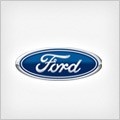
FORD Cortina
Generations Timeline, Specs and Pictures
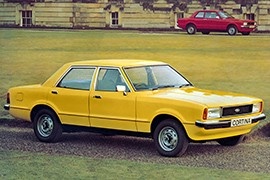
The 1976 Cortina was so much of a German Ford Taunus that it was almost impossible for a non-specialist to distinguish them one from another.
How the mighty have fallen. Once a great rally car and a respected car on the starting grids in any race, the Cortina became just a shadow of the glorious vehicle it was. Now it was available as a two-door sedan, a four-door sedan, and a station wagon. It was a commercial success, but it didn’t have that racy spirit as before. It was, basically, a facelifted version of the Taunus TC2 but sold in the same era.
Its predecessor featured a “Coca-Cola” bottle design for the rear fenders, but the accountants decided that it was cheaper to make a straight line. Its cabin featured slim A-pillars, and that was good for visibility. Over the years, the car also lost its round headlights and received a pair of rectangular ones fitted with turn-signals on their outer sides. Its black plastic grille was similar to the one installed on the German Taunus model.
Regardless of the body version, the Cortina offered enough room for five passengers, even if the middle one from the rear bench couldn’t stay there too long due to the high transmission tunnel that crossed the vehicle. For the station wagon version, Ford installed a folding seatback that could extend the trunk area.
Under the hood, Ford installed a small engine choice, but fit for every pocket. The base version featured a 1.6-liter inline-four engine, while the full-option model provided 110 hp from a 2.3-liter V-6 unit.
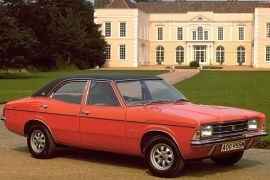
Ford U.K. and Ford Germany combined their forces under the new Ford of Europe name and jointly developed Cortina’s third generation, and their efforts paid off.
Launched in 1970, the Cortina marked a turning point for the blue-oval brand in Europe. It was inspired by the Coca-Cola bottle design trendy in the U.S. and introduced new engines and technologies. It was available as a coupe, four-door sedan, and station-wagon to answer all the market’s needs and, starting with 1972. It was Britain’s best-selling car until 1976 when the Escort overtook it.
The boxy design of the Cortina MKII was gone, and the new look took its inspiration from the European Taunus model. Its curved lines over the front and rear fenders made the vehicle looks more muscular. While it wasn’t longer than its predecessor, it featured a longer wheelbase, and it was 100 mm (4”) wider. The rear windscreen was sloped more than before, and that led to a sportier look.
But it wasn’t just a sportier exterior look. Inside, the carmaker installed a new dashboard and a raised area for the instrument panel. Depending on the engine size and trim level, the dials were either installed on a panel or scooped down in a binocular style. The carmaker mounted a panel on the center stack with other gauges in addition to the speedometer, tachometer, and clock. The interior room was adequate, thanks to its longer wheelbase than before.
Under the hood, Ford installed a wide range of engines, depending on the market. While the base model still featured the old 1.3-liter from its predecessor, there were a few new engines with overhead cams (OHC). Another significant improvement was on the comfort side, where the Cortina MK3 received a double-wishbone suspension.
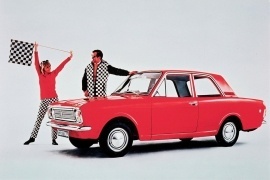
Ford introduced the second generation of the Cortina model in 1966, and it rocketed to the top of the sales chart faster than anyone else.
Finally, when the second generation of the Cortina stormed the dealers’ showrooms, the Austin was left in the rearview mirror. Ford was proud to defeat the small British carmaker that managed to stay ahead of them for a few years. But the second Cortina was truly an excellent blend. It was roomier than its predecessor and offered more comfort and more body versions than its British competitor.
When Roy Haynes designed the Cortina MK II, he might have peaked into Ford’s U.S. design department and got inspired by the Falcon. The new model was slightly shorter but wider than the Cortina MK I, and that led to a roomier interior and a bigger trunk. In the beginning, Ford offered the vehicle with only one bodywork option, but later on, it added the four-door sedan and the station wagon versions, which kept the Cortina MK II high on the sales chart.
Inside, the carmaker managed to introduce a higher-quality interior with better bucket seats and even a walnut trim on the dash panel for specific versions, such as the 1600 E-Executive launched at the Paris Motor Show. The new version was truly executive since it featured four doors and individual seats in the back, with a folding center armrest.
Under the hood, the Cortina received various engines, from the small 1.1-liter unit designed for Greece to a mighty 3.0-liter V-6 installed in South America. Lotus helped develop a new sporty version that was sold in Europe as the Cortina Twin-Cam.
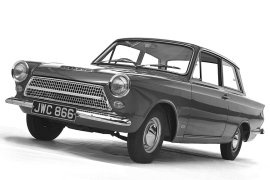
The Cortina was one of the most important vehicles from the ’60s British car industry.
It was the car that paved the way to sport-compact coupe vehicles.
Ford designed a concept-car in North America, named Cardinal. But ultimately, it decided that it was too small for Americans taste. So, they asked the British arm if that car would fit into their pans. The answer was “yes,” and the first car rolled down from the assembly line in 1962. But it wasn’t quite like the original, and it used the name Cortina instead.
The car was designed by Rory Brown Jr., who was sent into the U.K. after the disastrous design of the Ford Edsel. This time, he did it right. It was a light car, available in three body shapes: coupe, four-door sedan, and station wagon. They shared the same front fascia with a pair of round headlights and trapezoidal chromed grille. The descending bodywork lines were made the car looks faster. The round taillights split into three areas were a delight and became a classic theme design.
Inside, the Cortina featured a flat, straight dashboard with only a bump over the instrument cluster. It offered just about enough room for four passengers, with tilting front seats. There were not many features inside the cabin, allowing the carmaker to sell the vehicle with big discounts.
The drivetrain was simple, with an inline-four under the hood and a four-speed, all-synchromesh gearbox. To promote the car, Ford worked with Lotus to create a sporty version, and that’s how the Lotus Cortina appeared on the market. A light, agile, fast vehicle that won many races on the race-tracks’ tarmac and the gravel in rally stages.























































